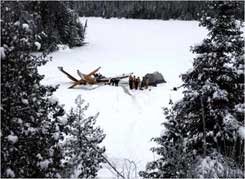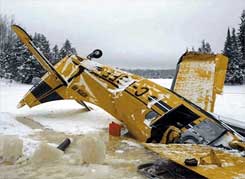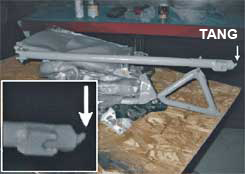Loss of Control After Take-Off
Huron Air & Outfitters Incorporated
de Havilland DHC-3 (Otter), C-GOFF
Jellicoe, Ontario
The Transportation Safety Board of Canada (TSB) investigated this occurrence for the purpose of advancing transportation safety. It is not the function of the Board to assign fault or determine civil or criminal liability. This report is not created for use in the context of legal, disciplinary or other proceedings. See Ownership and use of content. Masculine pronouns and position titles may be used to signify all genders to comply with the Canadian Transportation Accident Investigation and Safety Board Act (S.C. 1989, c. 3).
Summary
At approximately 0900Footnote 1 eastern standard time (EST), the pilot arrived at the airstrip and prepared the ski-equipped de Havilland DHC-3 (Otter) aircraft (registration C-GOFF, serial number 65) for the morning flight. This Otter was equipped with a turbine engine. Two passengers, with enough supplies for an extended period of time, including a snowmobile and camping gear, were to be flown to a remote location. The pilot loaded the aircraft and waited for the weather to improve.
At approximately 1200 EST, the pilot and passengers boarded the aircraft and took off in an easterly direction. The aircraft got airborne near the departure end of the airstrip, and, shortly after take-off, the right wing struck a number of small bushes and the top of a birch tree. The aircraft descended and struck the frozen lake surface, approximately 70 feet below the airfield elevation in a steep, nose-down, right-wing-low attitude. When it came to rest, the aircraft was inverted and partially submerged, with only the aft section of the fuselage remaining above the ice (Photo 2). All of the occupants were wearing lap belts. The pilot and front seat passenger received fatal injuries. The rear seat passenger survived the impact and evacuated the aircraft with some difficulty due to leg injuries. The following morning, about 22 hours after the accident, a local air operator searching for the missing aircraft located and rescued the surviving passenger.
Factual information
When the pilot did not return to his home base in Armstrong, Ontario, and had not reported in, the base operator assumed the satellite telephone carried on board was low on battery power, or the pilot was delayed and may have remained at the campsite with the passengers. It was not until the following morning that the base operator initiated a search by contacting another air operator near Jellicoe and asking them to locate and assist the aircraft. There were no reports of an emergency locator transmitter (ELT) signal being received by other aircraft or the Rescue Coordination Centre (RCC) at Trenton.
The pilot held a valid commercial pilot licence and was qualified for the flight. Records indicate the pilot was experienced flying the DHC-3 in a ski configuration. The pilot had a total flying time of 5016 hours with 540 hours on the accident aircraft since it was modified with the Walter M601E turbine engine. In the last 90 days he had flown 46 hours, and his work schedule did not indicate that he was fatigued. Autopsy results revealed no indication that incapacitation or physiological factors affected the pilot's performance.
The two passengers were familiar with the DHC-3 and similar aircraft types, since they often flew to remote northern locations. The surviving passenger reported being briefed on emergency procedures prior to the flight but could not recall if the briefing contained information regarding the location and use of the ELT.
At the time of the occurrence, the aviation routine weather report (METAR) for Geraldton, Ontario, located approximately 26 statute miles east of the occurrence site, was as follows: wind 010° True at 4 knots; visibility 2 statute miles in light snow; a broken cloud layer at 800 feet above ground level (agl), overcast cloud at 1100 feet agl; temperature minus 3°C and dew point minus 4°C. It was reported that snow was falling at Jellicoe for most of the morning. The pilot swept the snow off the aircraft, and once the sun broke through the cloud, visibility improved and the temperature was sufficiently mild to melt any snow on an aircraft's wings.
The airfield is located on private property, and the east/west airstrip is approximately 3400 feet long. Winter maintenance is limited to plowing a vehicle road that provides access to a maintenance hangar. Trees line the west and south sides of the airstrip, and at the east end of the runway there is a drop-off of approximately seventy feet to a lake. A metal tower, equipped with an anemometer, a windsock, and temperature and humidity transmitters is located at the midpoint of the airstrip on the north side.
The airstrip was covered with approximately 18 inches of snow over a snow-crust layer. The pilot had intended to taxi along the airstrip to pack down the snow, improving take-off performance by reducing the drag of the skis through the snow. However, for some reason, this was not accomplished. The three tracks created by the main landing gear skis and tail wheel during the take-off run were still visible when investigators arrived at the site. The length of the ski tracks, and hence the take-off run, was approximately 2800 feet.
Examination of the tracks showed that the main landing gear skis and the tail wheel had maintained contact with the snow throughout the take-off roll and had lifted off at the same moment, just prior to the departure end of the airstrip. The distance between lift-off and the end of the airstrip where the aircraft's wing contacted the brush was approximately 370 feet, and the impact with the tree was a short distance beyond that. Information obtained from the airstrip owner, the surviving passenger and a local air operator, who also operated a turbine-equipped Otter, indicated that this type of aircraft would normally be airborne by the mid-point of the airstrip, approximately abeam the metal tower.
The aircraft wreckage was removed from the lake and examined. The cockpit compartment and most of the fuselage aft of the cockpit was substantially damaged. Both wings had separated from the fuselage at the wing-to-fuselage attachment points. The right wing had substantially more damage than the left as a result of absorbing the initial impact forces with the frozen surface. From the mid-point of the fuselage to the tail section the damage was minor. The propeller separated from the engine and a section of the gearbox remained attached. The extensive curling and torsional twisting of the propeller blades indicated that the engine was producing substantial power at impact. A flight control examination revealed no anomalies. The main landing gear was equipped with wheel/skis. The wreckage examination determined the two skis were down during the take-off. The track markings in the snow at the airstrip also indicated the skis were in the down position. Examination of the wheel/skis revealed no sign of contamination on the base of the skis.
The horizontal stabilizer trim and flap positions were documented and compared against a serviceable aircraft of the same type. When the dimensions of the actuators were matched, it was determined that the horizontal stabilizer trim was in the full, nose-down position. The flap actuator extension was approximately 1¾ inches, which corresponded to a flap extension between climb and take-off. In discussion with another operator familiar with this type of aircraft, it was determined that it is common practice to adjust the horizontal stabilizer trim to full nose-down during the take-off run to assist in raising the tail section. Once successful, the trim is reset to its take-off setting, although if it remains in the full nose-down position, the control column forces can be overpowered by the pilot.
The total aircraft weight could only be estimated, since the fuel quantity on board was unknown. The flight manual supplement does not indicate the actual fuel consumption for the Walter M601E turbine engine, but other information indicated the average fuel consumption was 350 pounds of fuel per hour. The planned flight, including a 30-minute reserve, would have required a minimum fuel load of three hours. Using this value, the minimum fuel weight required for the flight would have been 1050 pounds. The aircraft take-off weight was then estimated to be approximately 7985 pounds, 15 pounds below the maximum allowable gross weight of 8000 pounds. The weight of the cargo was based on the contents removed from the aircraft. It was not determined if additional cargo was lost when the aircraft partially penetrated through the ice. The cargo was loaded in the forward area of the cabin and it was estimated that the centre of gravity was within limits.
Most of the cargo aboard the aircraft was not restrained. The only indication of restraints were ropes found near the snowmobile. The remainder of the equipment appeared to have been placed around or on top of the snowmobile. The cargo included some propane tanks and 5-gallon fuel containers.
It was determined that the folding, cabin utility seat, occupied by the survivor, failed in overload. Further examination revealed that the tangs (Photo 3) at the bottom of the seat legs, which are inserted into the floor pick-up plate for seat security, were facing rearward. A de Havilland Alert Service Bulletin (A3/49 dated 19 July 1991) called for an inspection of the tangs to verify they are facing forward. In this occurrence the impact was of sufficient force that the seat would have failed even if the tangs had been installed correctly.
The ELT was found secure in its support bracket at the rear of the aircraft and the control switch was in the armed position. The ELT's coaxial cable was found detached at the base of the external antenna, and the antenna had fractured and separated from the fuselage. The external antenna was located forward of the tail section. The ELT was a portable model equipped with a separate antenna, located on the support bracket, that could be attached to the ELT if it was removed from the aircraft. The survivor was not aware of the location in the aircraft of the ELT or that it was a portable unit that could be manually activated. However, the extent of his injuries and the attitude of the aircraft in the water would have made access to the ELT difficult in any case.
The ELT was removed and taken to an avionics repair facility for preliminary testing. When the external switch was selected on, the signal was audible and transmitting on 121.5 MHz. The batteries were fully charged and within their service life limits. The ELT was shipped to the TSB Engineering Branch (Report LP 007/2004 - ELT Examination) for further examinations and tests. The internal switch that triggers the activation, commonly known as the G switch, incorporates a tube and a ball that is free to move within the tube. On impact, the ball moves along the tube and activates the G switch. The switch is unidirectional, and an impact perpendicular to the ELT orientation, as in this occurrence, would not provide sufficient force to move the ball and activate the G switch. Presently, there are models of ELTs available with a multi-directional G switch that will activate if the impact loads are on any of six axes.
In December 2002, a Supplemental Type Certificate (STC) SA01-111, was implemented that allowed the replacement of the Pratt & Whitney R-1340 engine on the de Havilland DHC-3 (Otter) aircraft with the Walter M601E turbine engine. A second STC, SA02-112, that allowed for the installation of the AVIA Hamilton Standard VJ8-510 propeller on the landplane version of the DHC-3, was implemented at the same time. While the aircraft was at a maintenance facility, a Transport Canada inspector observed that a propeller, model number AVIA V508E-AG106A, which was not identified in STC SA02-112 but approved for installation on the seaplane version of the DHC-3, was installed on the aircraft. Subsequently, on 14 November 2003, Transport Canada issued a ferry-flight permit, valid for 30 days from the date of issue, that allowed the operator one flight to return the aircraft to its home base in Armstrong. No further flights in the aircraft were authorised until one of the following conditions were met: the operator re-installed the AVIA VJ8-510 propeller, or Transport Canada issued an approval for installation of the AVIA V508E-AG106A propeller on the landplane version of the DHC-3. Flights conducted without complying with these conditions could affect the validity of the aircraft's certificate of airworthiness. Entries in the aircraft journey logbook indicated that the aircraft had flown numerous flights since its return to Armstrong, without the above conditions being met.
As a result of the STCs, a U.S. Federal Aviation Administration (FAA) approved flight manual supplement (FMS) was supplied to the operator for the turbine-equipped Otter. When the STC was transferred to a Canadian company, the FMS was also accepted and referenced in the Canadian STC, approved by Transport Canada. A review of the FMS revealed that the performance section of the manual did not provide information for take-off and landing distances, but made reference to the similarities and differences in performance between the Otter powered by the Pratt & Whitney R-1340 engine and this turbine-equipped aircraft. The manual does not indicate whether the original DHC-3 Otter flight manual should be referenced to determine performance data.
Analysis
The pilot had originally intended to taxi the aircraft along the airstrip to pack down the snow. Since the aircraft was likely near maximum gross weight and the snow was quite deep, the skis plowed through the snow, impeding acceleration of the aircraft. It was not determined why the pilot did not conduct this runway preparation activity. The aircraft accelerated slowly and, near the end of the airstrip, the pilot forced the aircraft into the air with insufficient airspeed to climb out of ground effect and clear the obstacles. The aircraft was at or near the stall when it struck the brush and tree; it then departed controlled flight and crashed into the frozen surface of the lake.
The pilot did not attempt to abort the take-off prior to the end of the airstrip. An indication to the pilot that the aircraft was accelerating and capable of flying would be the raising of the tail. As indicated by the three separate ski and tire tracks in the snow, the tail of the aircraft was never flying until the aircraft got airborne near the end of the airstrip.
The ELT did not activate, likely because it was equipped with a unidirectional G switch. Even if it had activated, it probably would not have alerted the RCC because the external ELT antenna was severed during the impact sequence.
The following Engineering Laboratory report was completed:
- LP 007/2004 – ELT examination
This report is available from the Transportation Safety Board of Canada upon request.
Findings
Findings as to causes and contributing factors
- The pilot attempted to take off from an airstrip that was covered with approximately 18 inches of snow, and the aircraft did not accelerate to take-off speed because of the drag; the aircraft was forced into the air and was unable to climb out of ground effect and clear the obstacles.
- The pilot did not abort the take-off when it became apparent that the aircraft was not accelerating normally and before the aircraft became airborne.
Finding as to Risk
- Unidirectional G switches, which are found on many types of ELTs, do not always activate the unit when impact forces are not aligned with the usual direction of flight.
Other findings
- The validity of the aircraft's certificate of airworthiness was affected while it flew more flights than allowed by the ferry permit issued by Transport Canada.
- The rear passenger seat was found to be installed incorrectly, contrary to de Havilland Alert Service Bulletin A3/49, dated 19 July 1991.
This report concludes the Transportation Safety Board's investigation into this occurrence. Consequently, the Board authorized the release of this report on .


